

Gracenote unveils new Internet radio technology. By Dawn C.
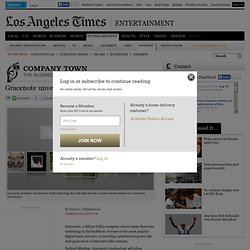
Chmielewski January 3, 2014, 6:20 a.m. Gracenote, a Silicon Valley company whose name-that-tune technology is the backbone of some of the most popular digital music services, is unveiling a platform to power the next generation of Internet radio stations. Dubbed Rhythm, Gracenote's technology will allow companies such as retailers and automobile manufacturers to offer their own Internet radio services to customers. Such brands would be looking for a way to capitalize music's popularity and on listeners' growing enthusiasm for streaming music services such as Pandora or Spotify. "We're seeing quite a few brands that want to use music to extend their engagement with consumers," said Gracenote President Stephen White. FACES TO WATCH 2014: Digital media Rhythm will allow companies to tap into Gracenote's database of information about more than 180 million songs, as well as the staff's music expertise, to create Internet radio stations tailored to a particular mood, tempo or era.
IAB Debuts Native Advertising 'Playbook' The Interactive Advertising Bureau Wednesday released the “IAB Native Advertising Playbook.”
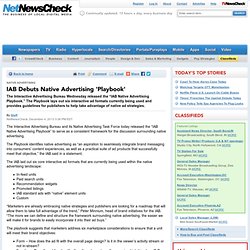
The Playbook lays out six interactive ad formats currently being used and provides guidelines for publishers to help take advantage of native ad strategies. The Interactive Advertising Bureau and its Native Advertising Task Force today released the “IAB Native Advertising Playbook” to serve as a consistent framework for the discussion surrounding native advertising.
The Playbook identifies native advertising as “an aspiration to seamlessly integrate brand messaging into consumers’ content experiences, as well as a practical suite of ad products that successfully meet that objective,” the IAB said in a statement. Story continues after the ad The IAB laid out six core interactive ad formats that are currently being used within the native advertising landscape: In-feed unitsPaid search unitsRecommendation widgetsPromoted listingsIAB standard ads with “native” element unitsCustom. Premium Publishers See Hope in 'Native' Sponsorships. Ad spending on sponsorships is growing faster than expected, as more premium publishers focus on selling customized, “native” digital executions, according to new figures from eMarketer.
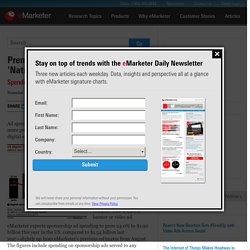
As display ad-buying becomes on the one hand ever more automated, with programmatic eating up a greater share of ad dollars each year, premium publishers are on the lookout for a way to stand out—and offer advertisers an experience that doesn’t compare with a typical banner or video ad. eMarketer expects sponsorship ad spending to grow 24.0% to $1.90 billion this year in the US, compared to $1.54 billion last year—slightly up from eMarketer’s previous estimates from August.
The figures include spending on sponsorship ads served to any digital devices. The growth comes as more advertisers rapidly increase spending on highly targeted programmatic inventory at the expense, in many cases, of more costly premium placements traditionally found on the homepages of large newspaper and magazine websites. Native advertising: Separating church and state. Credit: Image by Thinkstock Native advertising has been a key trend of 2013, with many publishers keen to benefit from this revenue stream.
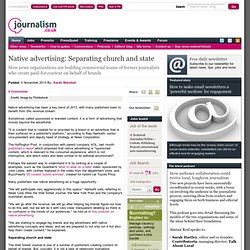
Sometimes called sponsored or branded content, it is a form of advertising that moves beyond the advertorial. "It is content that is created for or provided by a brand or an advertiser that is then surfaced on a publisher's platform," according to Raju Narisetti, senior vice-president and deputy head of strategy at News Corporation. The Huffington Post, in conjunction with parent company AOL, last month published a report which proposed that native advertising is "sponsored content, which is relevant to the consumer experience, which is not interruptive, and which looks and feels similar to its editorial environment". Many publishers see native advertising as a huge opportunity. Separating church and state The Wall Street Journal is one of a number of publishers creating content on behalf of brands.
Transparency And there are many ways to flag this up. BuzzFeed On Native Ads: Use Agency Model. David Spiegel, BuzzFeed's executive director of social publishing, told attendees at the Online Association's annual conference on Friday that publications wading into the native advertising waters should follow an agency model when working with clients, Spiegel says.
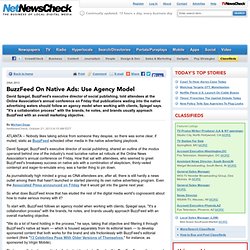
"It's a collaboration process" with the brands, he notes, and brands usually approach BuzzFeed with an overall marketing objective. ATLANTA -- Nobody likes taking advice from someone they despise, so there was some clear, if muted, static as BuzzFeed schooled other media in the native advertising playbook. David Spiegel, BuzzFeed's executive director of social publishing, shared an outline of the modus operandi behind one of the industry's most lucrative native ad rollouts at the Online News Association's annual conference on Friday.
Story continues after the ad So what does BuzzFeed know that has eluded the rest of the digital media world's cognoscenti about how to make serious money with it?